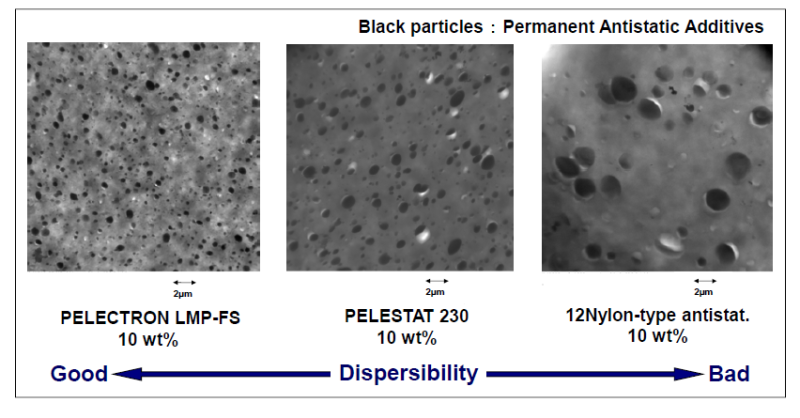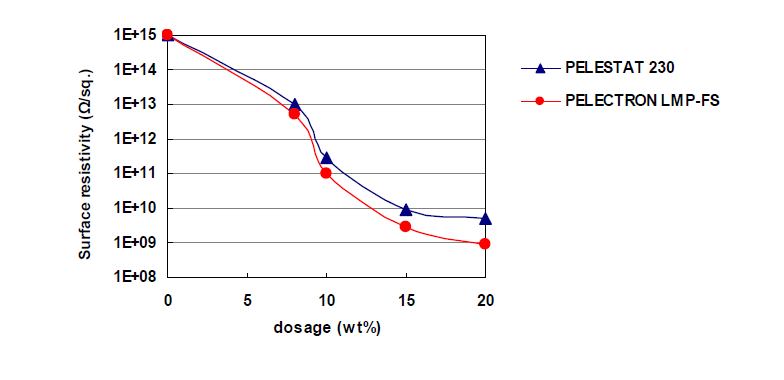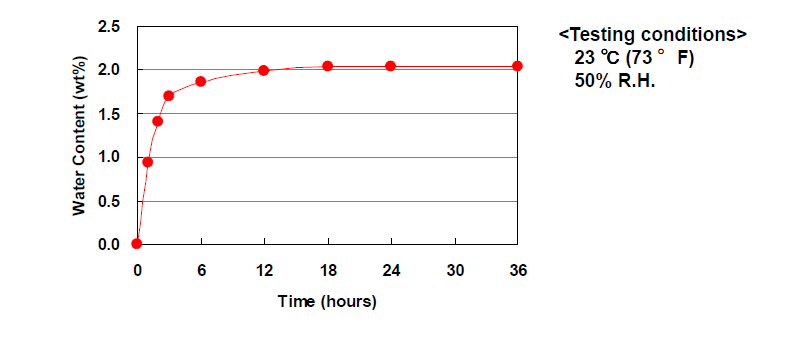Knowde Enhanced TDS
Identification & Functionality
- Plastics & Elastomers Functions
- Technologies
Features & Benefits
- Materials Features
- Features
- Excellent dispersibility into PE
- Excellent Heat-sealing property
- Low resistivity; Achieved surface resistivity range to 10^8-90/sq.
- Low dosage; Minimally affects the mechanical properties and moldability
Applications & Uses
- Markets
- Compatible Polymers & Resins
- Plastics & Elastomers End Uses
- Plastics & Elastomers Processing Methods
Properties
- Appearance
- Pale Yellow Pellet
- Typical Properties
- Physical properties
Property (Units) Test Method Dosage (wt %) LDPE
BlankPELESTAT
LMP-FS0 10 wt% Surface resistivity*1 (Ω/sq.) ASTM D257 10^16 10^10 Tensil Strength*2 (MPa) ASTM D638 24 23 Fracture elongation (%) ASTM D638 530 480 Haze (%) JIS K 7105 7 14 Total light transmittance JIS K 7105 91 89 *1 : 23℃ (73 °F), 50% R.H
<Extrusion and film conditions>
Temp.:170℃ (338 °F), Filmthickness:100 μm
| Value | Units | Test Method / Conditions | |
| Melt Flow Rate (at 190°C 374°F, 21.18 N) | approx. 15 | g/10min | — |
| Adapted Thermoplastic Resins | PE blown film PE, PP extrusion sheet | — | — |
| Melting Point | approx. 115 | °C | — |
| Melt Flow Rate (190°C (374°F), 21.18 N) | approx. 15 | g/10min | — |
| Surface Resistivity (23°C 73°F, 50% R.H) | 3×10^6 | — | — |
| Thermal Degradation Temperature | approx. 250 | °C | — |
| Surface Resistivity (23℃ (73 °F), 50% R.H) | 3×10*6 | Ω/sq. | — |
Technical Details & Test Data
- LDPE BLOWN FILM EXTRUSION

<Matrix resin:>
LDPE① [MFR=0.3 g/10min]
<Extrusion and blown film conditions>
Temp.:170℃(338 °F) , Filmthickness:100 μm, Blow rate:2.0
- Improvement of Heat Sealability

Contribution of
1. Low melting point
2. Dispersibility into PE<Composition>
LDPE① /L-LDPE④ /PELECTRON LMP-FS (or PELESTAT230)/Metallocene PE⑤
=67/15/13/5 (wt%)
<Extrusion and blown film conditions>
Temp.:170℃(338 °F) , Filmthickness:100 μm, Blow rate:2.0
<Heat-sealing conditions>
Both sides, Time:1 sec, Pressure:98 kPa, Temp.:120℃(248 °F),- Dispersibility into LDPE (TEM image)
 <LDPE resin> LDPE① [MFR=0.3 g/10min]
<LDPE resin> LDPE① [MFR=0.3 g/10min]
<Kneading conditions> Temp.:170℃ (338 °F), time:5 min- Effect of MFR(LDPE) on Surface Resistivity

<Extrusion and blown film conditions>
Temp.:170℃ (338 °F), Filmthickness:100 μm, Blow rate:2.0- Effect of Die Temp on Surface Resistivity (blown film )

<Composition>
LDPE① /L-LDPE④ /PELECTRON LMP-FS=72/15/13(wt%)
<Extrusion and blown film conditions>
Temp.:160℃~180℃ , Filmthickness:100 μm, Blow rate:2.0- Effect of Blow rate on Surface Resistivity (Blown film)

<Composition>
LDPE① /L-LDPE④ /PELECTRON LMP-FS
=72/15/13(wt%)
<Extrusion and blown film conditions>
Temp.:170℃ (338 °F), Filmthickness:100 μm, Blow rate:2.0- LDPE Sheet Extrusion

Dosage (wt%)
<Matrix resin:>
LDPE③ [MFR=2.0 g/10min
<Extrusion condition>
Temp.:170℃(338 °F)- Temperature dependence on heat-sealing Strength

<Composition>
LDPE①/L-LDPE④/PELECTRON LMP-FS/Metallocene PE⑤=67 /15 /13/5 (wt%)
<Extrusion and blown film conditions>
Temp.:170℃(338 °F) , Filmthickness:100 μm, Blow rate:2.0
<Heat-sealing conditions>
Both sides, Time:1 sec, Pressure:98 kPa- Polyethylene Resin used in the Evaluation
PE resin Supplier Grade MFR [190℃(374 °F) ,21.18 N] LDPE① Japan Polyethylene Co. LF128 0.3 LDPE② UBE-MARUZEN POLYETHYLENE Co. F022 0.7 LDPE③ UBE-MARUZEN POLYETHYLENE Co. F222 2.0 L-LDPE④ Sumitomo Chemical Co. FX CX4002 8.0 Metallocene PE Japan Polyethylene Co. KERNEL KS340T 3.5 - Correlation with Static Decay Time and Surface Resistivity

- Hygroscopic Properties of PELECTRON LMP-FS

<Example of drying conditions >
Drying under reduced pressure
Vacuum : Below 1,300 Pa (0.2 psi)
Temperature : 70 – 80 ℃ (158 – 176 °F)
Duration : 2 – 3 hoursHot-air drying
Temperature: 85 – 95 ℃ (185 – 203 °F)
Duration: 4 – 6 hours- LDPE Blown Film Extrusion (multi-layer)
Multi-layer film can reduce total amount of PELECTRON compared to single-layer film.

Figure 1: schematic view of multi-layer film

PELECTRON LMP-FS dosage in surface layer (wt%)

Figure 2:forming method of multi-layer film